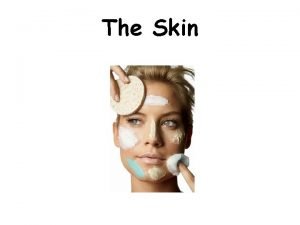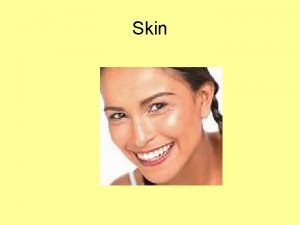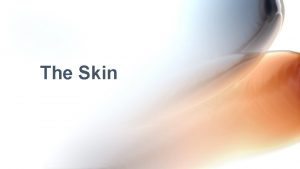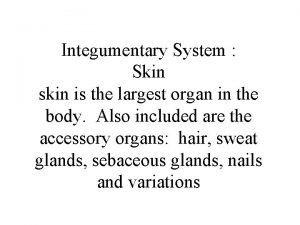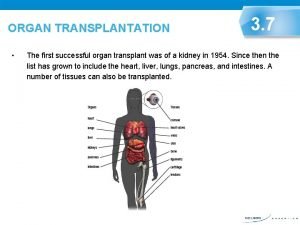Skin The skin is the first heaviest organ




















- Slides: 20

Skin

The skin is the first heaviest organ in the body 16 % of body weight, 1. 2 -2. 3 square meter. It is composed from the epidermis and dermis. Based on the thickness of the epidermis there are thick and thin skin. • The junction of dermis and epidermis is irregular, the projection of the dermis (papillae) interdigitate with epidermal evagination (epidermal ridge). • •

The skin functions are: 1. provide continuous communication with the environment (as receptor organ) 2. has protective action against ultraviolet rays (UV) by the action of Melanin pigment 3. Thermoregulator by the action of blood vessels , glands of the skin and the adipose tissue 4. Execretion of waste product and 5. Vit. D synthesis.

• Upon close observation, human skin show ridge and groove in the tips of the finger and volar surfaces of the hands and feet (palm and sole) called Dermatoglyphics, they are unique for each individual, appearing as loops, arches etc--- which are used for personal identification.

Epidermis: • The epidermis consists of a stratified squamous keratinized epith with three less abundant cell types: Melanocytes, Langerhans cells and Merkel's cells.

The epidermis consists of five layers: 1 - Stratum Basale (St. Germinativum ): • Is a single layer of columnar OR cuboidal basophilic cells resting on the basal lamina. • Desmosomes and Hemidesmosomes • High mitotic activity, this layer with the next layer responsible for constant renewal of epidermal cells (which occur every 15 -30 days). • The cells contain keratin intermediate filaments. As the cells progress upward, the number of filaments increases until it represent half of the protein in last layer.

• 2 -St. Spinosum (prickle layer): • St. spinosum consist of cuboidal cells with centrally located nuclei, the cytoplasm filled with bundles of keratin filaments (Tonofilament), these bundles terminated in the spiny cytoplasmic projection, the cells of this layer firmly bound together by cytoplasmic projections and Desmosomes. St. Basale and St. spinosum also called (malpigian layer)

St. spinosum

• 3 -St. Granulosum: • Consist of 3 -5 layers of polygonal cells, • Their cytoplasm are filled with basophilic granules called Keratohyalline granules which account for their basophilia. • Presence of lamellar granules which are surrounded by membrane, these granules fuse with the cell membrane and discharge their content into the intercellular spaces to form the intercellular cement which act as a barrier to prevent the penetration of foreign materials and provide important sealing effect in the skin.

4 -St. lucidum: • Is more apparent in thick skin, is translucent consist of eosinophilic flattened cells, • The organelles and nuclei are no longer evident • The cytoplasm consist of densly packed keratin filaments.

5 - St. corneum: • Consist of 15 -20 layers of flattened non-nucleated keratinized cells their cytoplasm are filled with filamentous scleroprotein called keratin. • Tonofilaments are packed together in a matrix contributed by the keratohyalline granules. • After keratinization, the cells consist of fibrillar proteins and thickened plasma membrane, they are called Horny cells. • During keratinization, lysosomal hydrolytic enzymes digest the organelles.

In psoriasis, there is an increase in the number of proliferating cells in the stratum basale and the stratum spinosum as well as a decrease in the cycle time of these cells. This result in greater epidermal thickness and more rapid renewal of epidermis.


Melanocytes: The colour of the skin is depends on the pigment called Melanin, the number of blood vessels and the color of the blood flowing in them. • Melanin is a dark brown pigment produced by the melanocyte found between the cells of St. basale and the hair follicles. • They have rounded cells bodies with long processes extend between St. basale and spinosum • Melanin is synthesized in the melanocytes. • Melanin granules once formed migrate by the cytoplasmic processes of melanocytes into the cells of St. basale and spinosum, then the melanin granules are injected into keratinocytes,

• Melanin granules accumulate in supranuclear area of the cytoplasm, to protect the nuclei from the deleterious effect of solar UV radiation. • Melanocytes are not distributed in a random way, they are about 1000 melnocytes/square mm in the skin of the thigh , and about 2000/square mm in the skin of scrotum. Sex and race does not influence the number of melanocytes/square mm, difference in skin color is due to the difference in the number of melanin granules in the keratinocytes. • Darkening of the skin color after exposure to sun light (Tanning) is due to 2 steps: 1 - Rapid release of pigment into the keratinocytes 2 - Acceleration of the rate of melanin pigment synthesis

In human lack of cortisol from the adrenal cortex causes overproduction of adrenocorticotropic hormone, which increases the pigmentation of skin. An example of this is Addison disease, which is caused by dysfunction of the adrenal glands.

Albinism, a hereditary inability of the melanocyte to synthesize melanin, is caused by the absence of tyrosinase activity. As a result the skin is not protected from solar radiation by melanin, and there is a greater incidence of basal and squamous cell carcinoma (skin cancer). The degeneration and disappearance of entire melanocytes result in a depigmentation disorder called Vitiligo

Langerhans's cells: Are star shaped cells found in the St. spinosum, they are bone marrow derived, they are capable of binding, processing and presenting antigens to T lymphocytes to stimulate them. So these cells are Ag-presenting cells.

Merkel's cells: They are present in thick skin of palm and soles, there are free nerve endings are present at the base of these cells, so, these cells serve as sensory mechanoreceptors.

Thank you
 Largest naturally occurring element
Largest naturally occurring element Heaviest metal
Heaviest metal Cell tissue organ organ system organism
Cell tissue organ organ system organism Tissues group together to form
Tissues group together to form Organ penyusun sistem gerak dan fungsinya
Organ penyusun sistem gerak dan fungsinya Organ and organ system
Organ and organ system Tractus respiratorius
Tractus respiratorius Organ penyusun sistem indra dan fungsinya
Organ penyusun sistem indra dan fungsinya Stratum granulosum
Stratum granulosum Thin skin vs thick skin
Thin skin vs thick skin Milady chapter 23 facial review questions
Milady chapter 23 facial review questions First layer of skin
First layer of skin Hát kết hợp bộ gõ cơ thể
Hát kết hợp bộ gõ cơ thể Bổ thể
Bổ thể Tỉ lệ cơ thể trẻ em
Tỉ lệ cơ thể trẻ em Gấu đi như thế nào
Gấu đi như thế nào Tư thế worms-breton
Tư thế worms-breton Chúa sống lại
Chúa sống lại Các môn thể thao bắt đầu bằng tiếng chạy
Các môn thể thao bắt đầu bằng tiếng chạy Thế nào là hệ số cao nhất
Thế nào là hệ số cao nhất


























